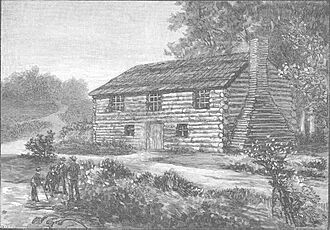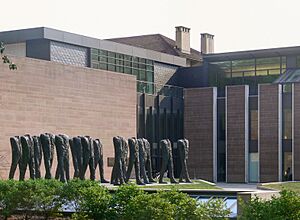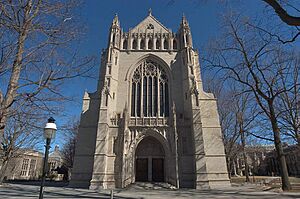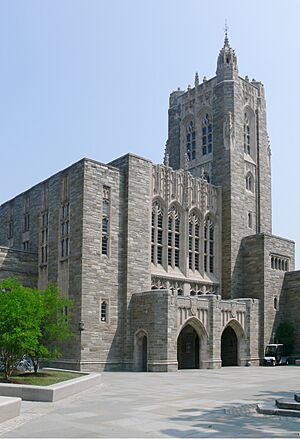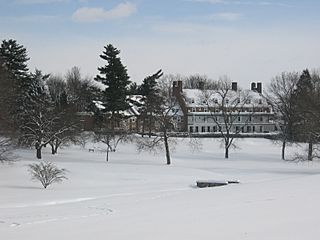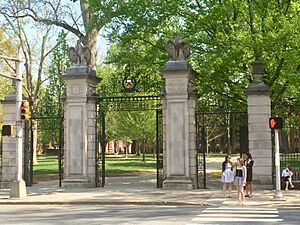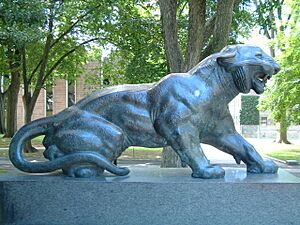Princeton University facts for kids
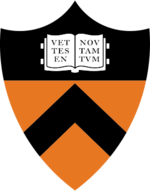 |
|
| Latin: Universitas Princetoniensis | |
|
Former names
|
College of New Jersey (1746–1896) |
|---|---|
| Motto | Dei Sub Numine Viget (Latin) On seal: Vet[us] Nov[um] Testamentum (Latin) |
|
Motto in English
|
"Under God's Power She Flourishes" On seal: "Old Testament and New Testament" |
| Type | Private research university |
| Established | October 22, 1746 |
| Accreditation | MSCHE |
|
Academic affiliations
|
|
| Endowment | $35.8 billion (2022) |
| President | Christopher L. Eisgruber |
| Provost | Jennifer Rexford |
|
Academic staff
|
1,068 (fall 2021) |
|
Total staff
|
7,300 |
| Students | 8,478 (fall 2021) |
| Undergraduates | 5,321 (fall 2021) |
| Postgraduates | 3,157 (fall 2021) |
| 2,631 (fall 2019) | |
| Location |
,
New Jersey
,
United States
40°20′43″N 74°39′22″W / 40.34528°N 74.65611°W |
| Campus | Small city, 600 acres (2.4 km2) |
| Newspaper | The Daily Princetonian |
| Colors | Black and Orange |
| Nickname | Tigers |
|
Sporting affiliations
|
|
| Mascot | The Tiger |
 |
|
Princeton University is a private Ivy League research university in Princeton, New Jersey. It was founded in 1746 as the College of New Jersey. This makes it the fourth-oldest college in the United States. It was one of the nine colleges started before the American Revolution. The school moved to its current location in 1756 and was renamed Princeton University in 1896.
Princeton is one of the richest universities in the world. It has the largest amount of money per student in the United States. This money, called an endowment, helps the university pay for its costs. About 8,500 students study subjects like humanities, sciences, and engineering at Princeton. The university has a huge library, one of the largest in the world.
The university is known for its beautiful campus and special traditions. Students live in groups called residential colleges. Older students can join "eating clubs," which are social groups where they eat meals together. Princeton's sports teams are called the Tigers, and they compete in the Ivy League against other top universities.
Many famous people have studied at Princeton. These include two U.S. presidents, James Madison and Woodrow Wilson. Twelve U.S. Supreme Court justices and many leaders in business and government also graduated from Princeton. Many Nobel Prize winners have also been connected to the university as students or teachers.
History
How Princeton Began
Princeton University was started by a group of religious leaders called Presbyterians. They were part of a movement known as the Great Awakening. They were unhappy with other colleges like Harvard and Yale. They wanted to create a new college to train ministers and other leaders.
They chose New Jersey because there were no other colleges between Connecticut and Virginia at the time. The governor granted a charter for the College of New Jersey on October 22, 1746. It first opened in Elizabeth, New Jersey. It was the fourth college created in the American colonies. The founders wanted students to learn about many different subjects, not just religion.
Early Years and the Revolution
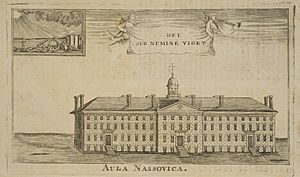
The college moved to Newark, New Jersey, in 1747. A year later, it received a new charter from Governor Jonathan Belcher. He was a big supporter of the college and donated his large library to it. In 1756, the college moved to its final home in Princeton, New Jersey. Its main building was Nassau Hall, named after King William III of England.
During the American Revolution, Princeton played an important role. John Witherspoon, the college president, signed the Declaration of Independence. In 1777, the Battle of Princeton was fought on the campus. American soldiers led by General George Washington captured Nassau Hall from the British. For four months in 1783, the Continental Congress met in Nassau Hall. This made Princeton the capital of the United States for a short time.
Changes in the 19th and 20th Centuries
Throughout the 19th century, Princeton grew and changed. It built more buildings and added more subjects for students to study. In 1896, the college officially became a university and changed its name to Princeton University.
In the early 20th century, Woodrow Wilson, who later became a U.S. president, was the president of Princeton. He made many important changes. He introduced a system of small discussion groups called "precepts," which are still used today. This allowed students to work closely with their teachers.
During World War I and World War II, Princeton supported the U.S. war effort. Many students served in the military, and the campus was used for research and training. After the wars, the university continued to grow and focus more on scientific research.
Becoming a Modern University
One of the biggest changes in Princeton's history was when it began admitting women. For over 200 years, only men could be students. In 1969, the first female undergraduate students enrolled at Princeton. This made the university a coeducational institution, meaning it educates both men and women.
In recent decades, Princeton has worked to become more diverse. It has welcomed students from all backgrounds. The university has also focused on making education affordable. In 2001, it became the first university to replace all student loans with grants in its financial aid packages. This means students from families with lower incomes can graduate without debt.
Campus
Princeton's main campus is over 600 acres and has more than 200 buildings. Many of the buildings are in the Collegiate Gothic style, which looks like old European universities with stone walls and towers.
The oldest building is Nassau Hall, built in 1756. It was once the temporary capitol of the United States. Today, it holds the office of the university's president. In front of Nassau Hall is a large lawn called Cannon Green. Two cannons from the Revolutionary War are buried there.
At the southern edge of campus is Lake Carnegie, a man-made lake. It was built in 1906 for the university's rowing team. The campus also has many beautiful gardens and outdoor sculptures by famous artists like Pablo Picasso and Henry Moore.
Important Buildings
Nassau Hall
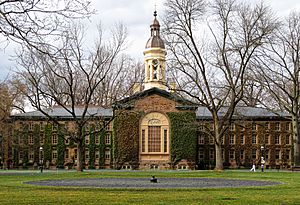
Nassau Hall is the most historic building on campus. It survived the Battle of Princeton and served as the nation's capitol. Today, it is a symbol of the university. Graduations are held on the front lawn of Nassau Hall. Two large bronze tiger statues guard the entrance.
Art Museum
The Princeton University Art Museum was founded in 1882. It has a huge collection of over 112,000 objects from all over the world. The collection includes ancient Roman mosaics, paintings by famous artists like Monet and Van Gogh, and art from Asia, Africa, and the Americas.
University Chapel
The Princeton University Chapel is a large, beautiful church on campus. It was built in the 1920s and looks like a medieval English cathedral. It is one of the largest university chapels in the world. The chapel has stunning stained-glass windows and detailed stone carvings. It is used for religious services and special university events.
Academics
Princeton offers two types of bachelor's degrees: a Bachelor of Arts (A.B.) and a Bachelor of Science in Engineering (B.S.E.). To graduate, all students must do independent work. This includes writing junior papers and a senior thesis, which is a long research paper on a topic in their major.
Classes at Princeton are often small. Many classes have fewer than 20 students. This allows students to work closely with their professors. The university also uses a precept system. In addition to lectures, students meet in small groups called precepts to discuss what they are learning.
Princeton has an "Honor Code." This means students promise not to cheat on exams. They take their tests without a professor in the room. Students are responsible for watching over each other and reporting any problems.
Research
Princeton is a top research university. This means that professors and students work on discovering new things in many fields. The university receives hundreds of millions of dollars each year for research projects.
Princeton manages two major national laboratories. The Princeton Plasma Physics Laboratory works on creating clean energy through nuclear fusion. The Geophysical Fluid Dynamics Laboratory studies climate change and weather patterns.
Library System
The Princeton University Library is one of the largest in the country. It has over 13 million items, including seven million books. The main library is Firestone Library. There are also several smaller libraries for specific subjects like art, music, and engineering. The library holds rare items, like the original handwritten manuscript of The Great Gatsby by F. Scott Fitzgerald.
Student Life
Residential Colleges
Almost all undergraduate students live on campus. First-year students and sophomores are required to live in one of seven residential colleges. These colleges are like mini-communities within the university. Each one has its own dining hall, common rooms, and staff who help students. The colleges are:
Eating Clubs
A unique part of Princeton life is its eating clubs. These are private clubs for juniors and seniors. They are not run by the university. Students eat their meals at the clubs and use them as centers for social life. There are ten eating clubs located on Prospect Avenue, a street near the campus. Some clubs accept members on a first-come, first-served basis, while others have a selective interview process.
Traditions
Princeton has many fun traditions. One is a large bonfire on Cannon Green. It is only held if the Princeton football team beats both Harvard and Yale in the same season. Another tradition says that students should not walk out of the main campus gate, called FitzRandolph Gate, until they graduate. If they do, they might not graduate.
A famous tradition is Princeton Reunions. Every year, thousands of former students, called alumni, return to campus for a weekend of celebrations. The highlight is the "P-rade," a parade where alumni from every class march through campus.
Athletics
Princeton's sports teams are called the Princeton Tigers. Their colors are orange and black. Princeton competes in NCAA Division I and is a member of the Ivy League. The university has 37 varsity sports teams for men and women.
Princeton has a long and successful history in sports. In 1869, Princeton played in the first-ever American college football game against Rutgers University. The men's basketball team has won many Ivy League titles. The men's lacrosse team won six national championships between 1992 and 2001. Many Princeton athletes have also competed in the Olympic Games.
Notable People
Many famous and successful people have graduated from Princeton.
- U.S. Presidents: James Madison and Woodrow Wilson.
- First Lady: Michelle Obama.
- Supreme Court Justices: Samuel Alito, Elena Kagan, and Sonia Sotomayor.
- Business Leaders: Jeff Bezos, founder of Amazon, and Eric Schmidt, former chairman of Google's parent company.
- Actors: Jimmy Stewart, Brooke Shields, and David Duchovny.
- Writers: F. Scott Fitzgerald and Jodi Picoult.
- Scientists: Alan Turing, a pioneer of computer science, and Richard Feynman, a Nobel Prize-winning physicist, earned their Ph.D.s at Princeton.
Albert Einstein was not a professor at Princeton, but he worked at the nearby Institute for Advanced Study. He often visited the campus and gave lectures.
Images for kids
-
John Witherspoon, President of the college (1768–94) and signer of the Declaration of Independence
-
The eastern side of the Washington Road Elm Allée, one of the entrances to the campus
-
McCarter Theatre, where the Princeton Triangle Club premiers its Triangle Show
-
Princeton vs. Lehigh football, September 2007
-
The annual Cane Spree depicted in 1877
-
The Princeton University Class of 1879, which included Woodrow Wilson
-
Archival record from the Graduate School detailing Alan Turing's academic journey
See also
 In Spanish: Universidad de Princeton para niños
In Spanish: Universidad de Princeton para niños


